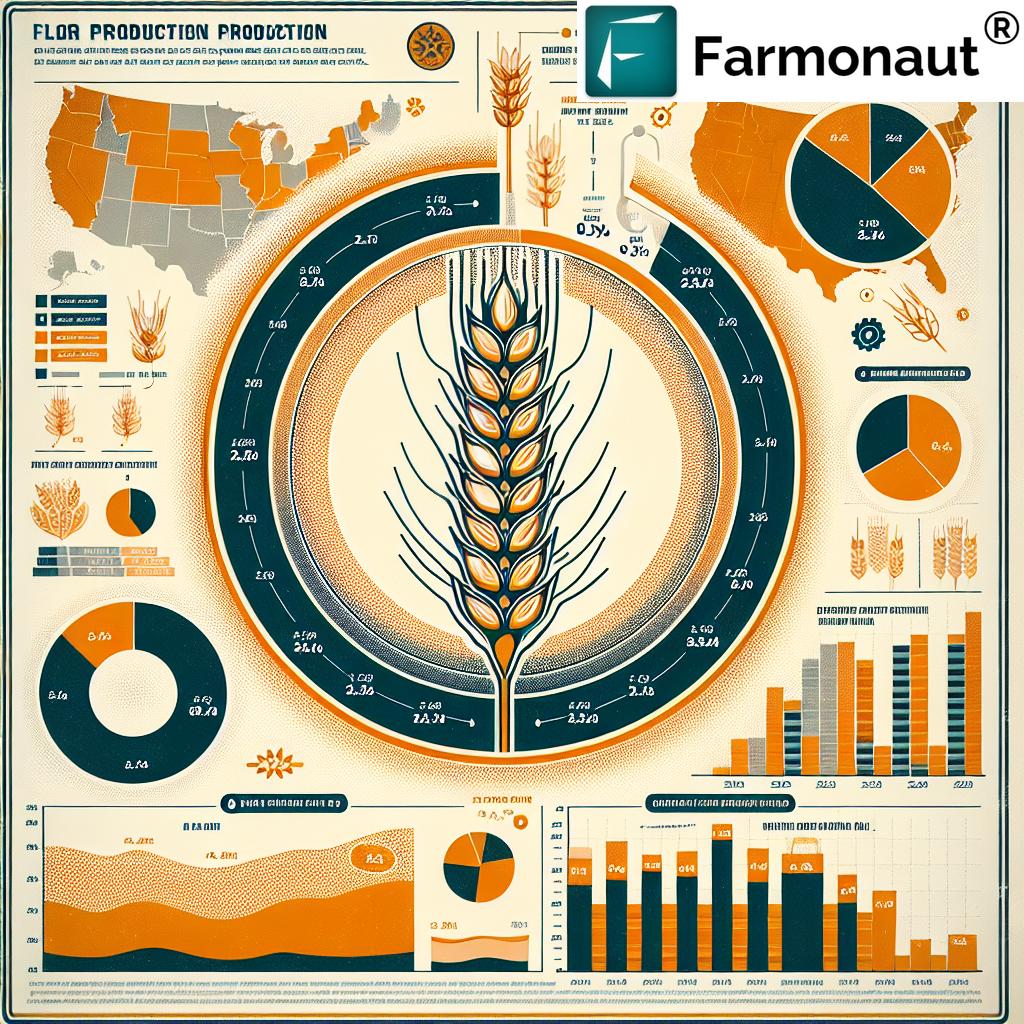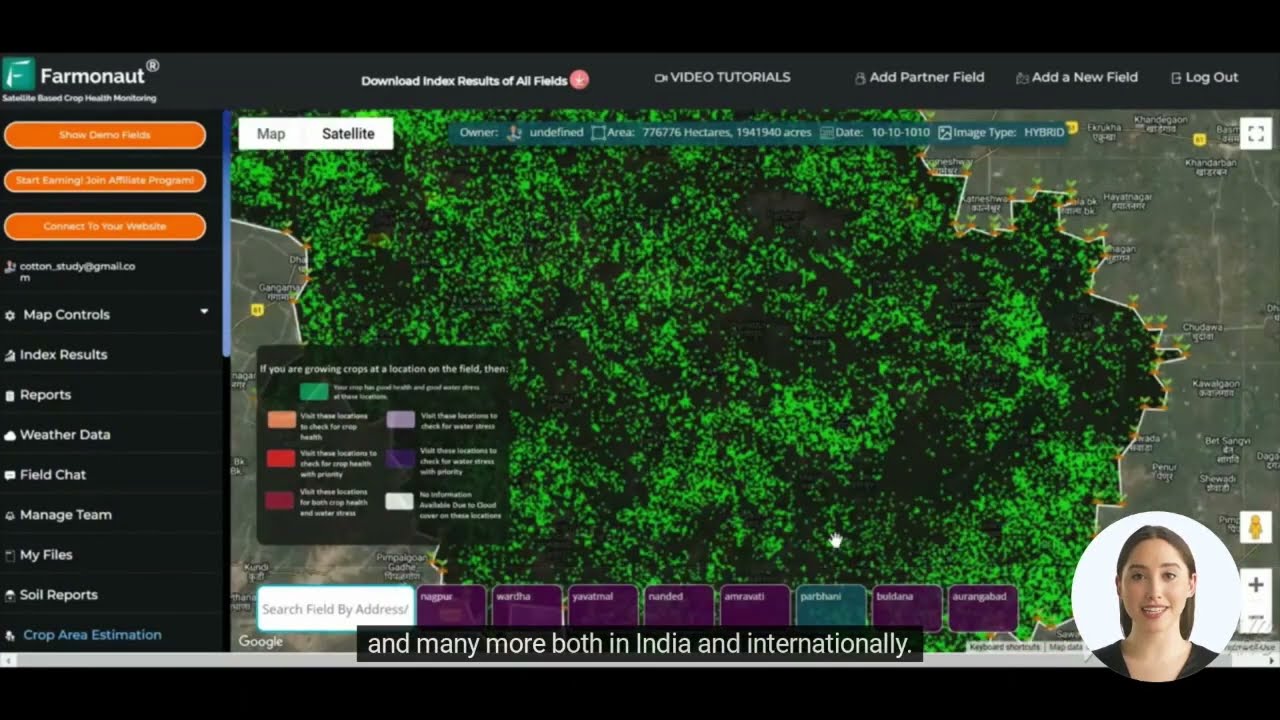US Flour Production Rises 1.2% in 2024: Industry Trends and Capacity Utilization Analysis
“US flour production reached 425,179,000 cwts in 2024, a 1.2% increase from 2023 but below the 2022 record.”
As we delve into the latest US flour production statistics for 2024, we find ourselves navigating a landscape of modest growth and ongoing challenges in the milling industry. The United States Department of Agriculture’s National Agricultural Statistics Service has recently released its comprehensive report, shedding light on the intricate dynamics of flour production, capacity utilization, and market trends that shaped the industry over the past year.
In this analysis, we at Farmonaut will explore the nuances of these findings, offering insights into what they mean for farmers, millers, and the broader agricultural sector. Our expertise in satellite-based crop monitoring and AI-driven agricultural advisory services provides us with a unique perspective on how these production trends relate to the wider context of crop health, yield estimation, and resource management in the wheat farming sector.
2024 Flour Production Overview: A Year of Modest Growth
The year 2024 saw US flour production reach 425,179,000 hundredweight (cwts), marking a 1.2% increase from the previous year. This growth, while positive, tells a story of an industry still finding its footing in a post-pandemic world. Let’s break down the key figures:
- Total production: 425,179,000 cwts
- Year-over-year increase: 5,181,000 cwts (1.2%)
- Comparison to record year (2022): 5,105,000 cwts below peak
This increase is encouraging, yet it’s important to note that production levels remain below the record set in 2022 and fall short of figures seen in other recent years such as 2020, 2018, and 2017. This trend suggests that while the industry is showing resilience, it continues to face headwinds that are preventing a return to peak production levels.

Quarterly Production Trends: A Closer Look
To gain a more granular understanding of the production landscape, let’s examine the quarterly data for 2024:
- Fourth quarter production: 107,331,000 cwts
- Year-over-year increase (Q4): 1.9%
- Quarter-over-quarter change: 0.1% decrease from Q3
The fourth quarter figures are particularly telling. While showing growth compared to the same period in 2023, they represent the lowest final quarter output since 2019. This underscores the complex nature of the recovery in flour production, with progress being made but challenges still evident.
At Farmonaut, our satellite-based crop monitoring tools can provide valuable insights into the factors influencing these production trends. By analyzing vegetation health indices (NDVI) and soil moisture levels across wheat-growing regions, we can help identify potential causes for production fluctuations, such as weather patterns or crop health issues.
Capacity Utilization: A Key Indicator of Industry Health
“American wheat flour mills operated at 86.4% capacity in 2024, slightly above the 10-year average utilization rate.”
The capacity utilization rate of flour mills is a crucial metric for understanding the efficiency and overall health of the milling industry. In 2024, we observed the following:
- Annual capacity utilization: 86.4%
- Improvement from 2023: 0.4 percentage points
- Comparison to recent peaks: Still below 88.4% seen in 2022 and 2021
- 10-year average (2014-2023): 85.9%
These figures paint a picture of an industry operating at a relatively stable level, slightly above the long-term average but not yet returning to the higher utilization rates seen in the immediate past. This suggests that while demand for flour remains strong, there may be factors limiting mills’ ability to operate at full capacity.
Our Jeevn AI advisory system at Farmonaut can help millers and wheat farmers alike optimize their operations in response to these capacity utilization trends. By providing real-time insights and expert crop management strategies, we can assist in aligning production more closely with market demand.
Wheat Grind and Millfeed Production: Supporting Data
To fully understand the flour production landscape, it’s essential to look at related metrics such as wheat grind and millfeed production:
- Fourth quarter wheat grind: 230,786,000 bushels (1.8% year-over-year increase)
- Fourth quarter millfeed production: 1,636,755 tons (2.4% increase from 2023)
These figures corroborate the overall trend of modest growth in the flour industry. The increase in wheat grind volume is particularly noteworthy, as it outpaces the growth in flour production, potentially indicating improvements in milling efficiency or changes in wheat quality.

Specialized Flour Production: Diverging Trends
An examination of specialized flour production reveals interesting divergences within the industry:
- Whole wheat flour (Q4 2024): 4,548,000 cwts (slight decrease)
- Semolina production (Q4 2024): 8,250,000 cwts (3.3% increase)
- Rye flour production (Q4 2024): 152,000 cwts (13% decrease)
These figures highlight the varying fortunes of different flour types. While semolina production saw significant growth, possibly driven by increased demand for pasta products, whole wheat flour remained relatively stable. The sharp decline in rye flour production is particularly noteworthy and may reflect changing consumer preferences or challenges specific to rye cultivation.
At Farmonaut, our satellite-based crop monitoring can be particularly valuable for farmers growing specialized wheat varieties or rye. By providing detailed insights into crop health and growth patterns, we can help farmers optimize their production to meet market demands for these specialized flours.
Industry Challenges and Future Outlook
While the 1.2% increase in flour production is a positive sign, the industry continues to face several challenges:
- Production levels below recent peak years
- Fluctuating demand for specialized flours
- Potential impacts of climate change on wheat production
- Ongoing supply chain and logistical challenges
These challenges underscore the need for innovative solutions in the agriculture and milling sectors. At Farmonaut, we’re committed to providing tools that can help address these issues. Our satellite-based crop monitoring, AI-driven advisory services, and blockchain-based traceability solutions can assist farmers and millers in navigating these complex market conditions.
For instance, our carbon footprinting feature can help agribusinesses monitor and reduce their environmental impact, an increasingly important factor in today’s market. Additionally, our fleet and resource management tools can optimize logistics, potentially alleviating some of the supply chain pressures facing the industry.
Comparative Annual Flour Production Data
| Year | Total Flour Production (cwts) | Year-over-Year Change (%) | Capacity Utilization (%) | Whole Wheat Flour Production (cwts) | Semolina Production (cwts) |
|---|---|---|---|---|---|
| 2024 | 425,179,000 | +1.2% | 86.4% | 4,548,000 (Q4) | 8,250,000 (Q4) |
| 2023 | 419,998,000 | -2.4% | 86.0% | Data not available | Data not available |
| 2022 | 430,284,000 | +0.5% | 88.4% | Data not available | Data not available |
This table provides a clear overview of the production trends over the past three years, highlighting the modest recovery in 2024 after a dip in 2023, while still falling short of the 2022 peak. The capacity utilization rates reflect the industry’s gradual return to higher operational levels.
The Role of Technology in Addressing Industry Challenges
As the flour production industry navigates these complex trends, technology plays an increasingly crucial role in optimizing operations and addressing challenges. At Farmonaut, we’re at the forefront of this technological revolution in agriculture.
Our satellite-based crop health monitoring system provides invaluable data on wheat crops across vast areas, enabling farmers to make informed decisions about irrigation, fertilizer usage, and pest management. This technology can help increase wheat yields and quality, potentially addressing some of the supply-side challenges facing flour mills.
Furthermore, our AI-driven Jeevn advisory system offers personalized recommendations to farmers, helping them optimize their crop management strategies. This can lead to more consistent wheat production, potentially stabilizing supply for flour mills.
For millers and agribusinesses, our blockchain-based traceability solutions can enhance supply chain transparency, addressing concerns about product origin and quality. This technology can be particularly valuable for specialty flours like whole wheat and semolina, where consumers may have heightened interest in the product’s journey from farm to table.
Implications for Farmers and Agribusinesses
The trends observed in the 2024 flour production data have several implications for wheat farmers and agribusinesses:
- Steady demand for wheat, with potential for growth in specialty varieties
- Need for improved efficiency to meet capacity utilization targets
- Importance of adapting to changing consumer preferences, particularly in specialty flours
- Potential opportunities in sustainable and traceable wheat production
Farmers can leverage Farmonaut’s technology to address these challenges and opportunities. Our satellite-based crop monitoring can help optimize wheat production, while our blockchain solutions can provide the traceability increasingly demanded by consumers and regulators alike.
To explore how Farmonaut can support your agricultural operations, visit our web app or check out our mobile applications:
The Future of Flour Production: Embracing Innovation
As we look to the future of flour production in the United States, it’s clear that innovation will play a key role in addressing the industry’s challenges and capitalizing on opportunities. The modest growth seen in 2024 suggests that there’s room for improvement and optimization across the wheat-to-flour supply chain.
At Farmonaut, we believe that the integration of advanced technologies like satellite imaging, AI, and blockchain will be crucial in driving this innovation. Our tools can help:
- Improve wheat crop yields and quality through precision agriculture
- Optimize supply chain logistics to enhance mill capacity utilization
- Provide transparency and traceability to meet evolving consumer demands
- Support sustainable farming practices to address environmental concerns
For developers and businesses looking to integrate our advanced agricultural data into their own systems, we offer comprehensive API access. Explore our API and API Developer Docs to learn more about leveraging Farmonaut’s technology in your applications.
Conclusion: Navigating the Future of US Flour Production
The 1.2% increase in US flour production in 2024 paints a picture of an industry in recovery, albeit with ongoing challenges. While production levels have improved from 2023, they still lag behind the peaks seen in recent years. The varying fortunes of different flour types, from the growth in semolina to the decline in rye flour, highlight the need for adaptability in the face of changing market demands.
As we move forward, the integration of advanced technologies will be crucial in addressing the industry’s challenges and capitalizing on opportunities. At Farmonaut, we’re committed to providing innovative solutions that can help farmers, millers, and agribusinesses navigate this complex landscape.
By leveraging satellite-based crop monitoring, AI-driven advisory services, and blockchain-based traceability, we can work together to build a more resilient, efficient, and sustainable flour production industry. The modest growth seen in 2024 is just the beginning – with the right tools and strategies, we believe the US flour industry can rise to new heights in the years to come.
Frequently Asked Questions
- Q: What was the total US flour production in 2024?
A: The total US flour production in 2024 reached 425,179,000 hundredweight (cwts). - Q: How does the 2024 production compare to previous years?
A: The 2024 production was 1.2% higher than 2023 but still below the record set in 2022 of 430,284,000 cwts. - Q: What was the capacity utilization rate for US flour mills in 2024?
A: US flour mills operated at 86.4% of their six-day production capacity in 2024. - Q: How did whole wheat flour production fare in 2024?
A: Whole wheat flour production saw a slight decrease in the fourth quarter of 2024, totaling 4,548,000 cwts. - Q: What trends were observed in semolina production?
A: Semolina production increased by 3.3% in the fourth quarter of 2024, reaching 8,250,000 cwts. - Q: How did rye flour production change in 2024?
A: Rye flour production experienced a significant decline of 13% in the fourth quarter of 2024, falling to 152,000 cwts. - Q: What factors might be influencing these production trends?
A: Factors such as changing consumer preferences, supply chain challenges, weather patterns, and overall economic conditions could all be influencing these production trends. - Q: How can technology like Farmonaut’s help address challenges in flour production?
A: Farmonaut’s satellite-based crop monitoring, AI advisory systems, and blockchain traceability solutions can help optimize wheat production, improve supply chain efficiency, and enhance product transparency.
Earn With Farmonaut
Earn 20% recurring commission with Farmonaut’s affiliate program by sharing your promo code and helping farmers save 10%. Onboard 10 Elite farmers monthly to earn a minimum of $148,000 annually—start now and grow your income!
For more information about our affiliate program, visit Earn With Farmonaut.
Farmonaut Subscriptions
















